|
Airplanes and Rockets website
visitor Tony B. wrote to ask that I scan and post this McDonnell F-4 Phantom
article, written by noted aviation historian
Don Berliner and having a highly detailed drawing by
Björn Karlström. Berliner provides a lot of history on the Phantom, beginning
with the FH-1 Phantom 1, designed and built by the
McDonnell
Aircraft Corporation in the days before it merged with
Douglas Aircraft
Company in 1967. The F-4M was the most recent version when this article was
published in the May 1970 issue of American Aircraft Modeler. The U.S.
Navy's Blue Angels demonstration
team flew F-4J models during airshows from 1969 to 1974, which was the core of the
Viet Nam era. Having grown up in
Mayo, Maryland,
just a few miles south of Annapolis, I watched the Blue Angels perform for the
U.S. Naval Academy graduation ceremonies. Most
of the time it was from my back yard where they flew enroute to the Navy Stadium
during each pass. Up until 1960 it was not uncommon for the Blue Angels to make
a supersonic pass at the beginning of the show, causing the
sonic boom to scare the
bejeepers out of spectators
and unsuspecting homeowners in the surrounding area. Sonic booms over populated
areas were outlawed in 1969, but I remember hearing - and feeling - them often in
prior years. I can't remember the last time I heard one - 'twould be nice.
McDonnell F-4 Phantom
Don Berliner
|
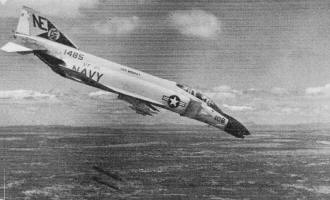
U.S. Navy F-4 Phantom
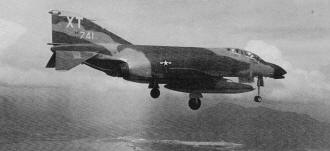
F-4 Phantom jet, wheels down
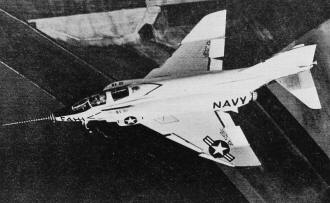
McDonnell F-4Phantom on the deck
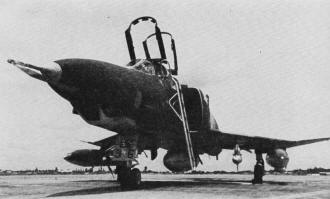
F-4 Phantom in Viet Nam camouflage
|
Built in 19 versions and numerous variants this internationally famous aircraft
carries three times the load of a WW-II B-17, has a remarkable speed range of 12
to one. And that's just the beginning.
From Phantom to Banshee to Demon and back to Phantom.
The completion of a full circle? No, more like a sharp upward spiral, for the
first Phantom bears only the faintest similarity to the potent Phantom II which
has been the first-line fighter/attack bomber of the U. S. for many years and is
assuming a similar role with the British and Israeli air arms.
When the slender, graceful McDonnell FH-1 Phantom I completed its carrier qualification
tests in July, 1946, the U. S. Navy had its first jet fighter, though its performance
was not up to that of the Army Air Force's classic P-80 Shooting Star. But when
the F4H-1 Phantom II qualified for carrier operations in early 1960, the Navy found
it had an airplane equal or superior to any in the world.
Really, for the first time, the Navy did not have to be content with a second-rate
fighter plane. All the old handicaps of carrier operation - extra equipment, performance-killing
weight of a beefed-up structure to withstand the shock of landing - were completely
over-whelmed by a fine design and plenty of power.
And final proof came in March, 1962, when the USAF ordered Phantom II's for its
own use, thus for the first time recognizing a carrier plane as superior to land-based
craft of the same class. Inter-service rivalry being what it is, such a move was
not made without careful thought. Since the Navy received its first production F4H-1's
in 1961, the Phantom II has been out front.
Performance is the outstanding characteristic of the ungainly machine, for it
is three times as fast, and will climb twice as high in 1/6th the time of its grandfather,
the FH-1. World records by various versions of the F-4 are the clearest indication
of its potency, for they were made by standard military aircraft which had to be
performing below still-secret maximums.
Its best: 16 km, straightaway run: 1,606 mph; 3 km. low-altitude straightaway
run: 902 mph; 100 km. closed-course run: 1,390 mph; 500 km, closed-course run: 1,216
mph.
Los Angeles to New York: 2 hours, 48 minutes (869 mph).
Sustained altitude: 66,443 ft.; maximum alti tude: 98,557 ft.
Climb to 9,842 ft.: 34.5 sec.; climb to 19,685 ft.: 48.8 sec.; climb to 29,527
ft.: 1 min., 1.6 sec.: climb to 39,370 ft.: 1 min., 17.2 sec.: climb to 49,212 ft.:
1 min., 54.5 sec.; climb to 65,617 ft.: 2 min., 58.5 sec.; climb to 82,021 ft.:
3 min., 50.4 sec.: climb to 98,425 ft.: 6 min., 11.4 sec.
The Phantom II started out life as a long-range, all-weather attack fighter -
a replacement for the none-too-successful McDonnell F3H Demon of the 1950's. Little
by little, the machine became more powerful and more complicated and more versatile.
The resulting airframe with its upturned wingtips, downturned stabilizers and bulging
nose was wrapped around a pair of General Electric J-79 engines rated at more than
17,000 lbs. of thrust each, with afterburning, So, despite its considerable weight
which can go over 55,000 lbs., the Phantom II is one of those rare aircraft which
can do many jobs well
Air Force KF-4C reconnaissance at Udern, Thailand. Opposite, top to bottom: Navy
F-4B Phantom from carrier Midway drops bombs on Viet Cong in ground support over
South Vietnam; Air Force F-4C approaches Cam Kahn Bay, South Vietnam - outline of
carrier-deck arresting hook may be seen aft of twin tail pipes; Navy's first twin-seat
supersonic fighter during tests. Climb to 30,000 ft. barely exceeds one minute.
Top 1,606 mph, maximum altitude 98,557 ft.
As a bomber, it can carry 18 750-lb. bombs, or 15 680-lb. mines, or 11 1,000-lb.
bombs, or 11 150-gal. napalm tanks, or four Bullpup multiple rocket packages, or
... For many fighter Phantoms, the basic load includes four Sparrow radar-guided
air-to-air missiles and four Falcon infrared-guided missiles. Other armament can
include one or more 6,000-rounds-per-minute, 20-mm. cannon; pods of 2.75- or 5-in.
rockets; Shrike air-to-ground missiles; or any of a variety of free-fall bombs,
bomb dispensers and bomb clusters. In all, the F-4 can carry about three times the
normal load of the standard U. S. bomber of World War II - the nine-man, four-engine
B-17.
To direct the airplane and control all its armament is a great collection of
electronic gear: pulse Doppler radar fire control systems, radar bombing systems,
solid state communication/navigation/identification/and counter-measures systems.
The reconnaissance versions carry an equally elaborate array of optical, infrared
and electronic sensors, including many types of cameras with automatic in-flight
film processing and film ejection, and extensive data recording equipment.
Since the earliest days of aviation, one of the simplest measures of an airplane's
worth has been its speed range: top speed divided by minimum flying speed. For most
common types, the range is no more than three or four to one. For the Phantom II,
it is fully 12 to 1, thanks to terrific top speed and some clever devices which
give it a bottom speed o( about 130 mph with everything hanging down. To achieve
this, the engineers at McDonnell (now McDonnell Douglas) applied full-span drooping
leading edges on the wings, boundary-layer control via compressor air blown over
the flaps, spoilers taking the place of "up" aileron, and interconnected ailerons
and rudder for low-speed control.
To make the versatility of the Phantom II meaningful and not just a novelty to
be shown off at the Paris Air Show, it has been fitted out with sufficient fuel
tanks to give it highly unusual range for an airplane with a pair of kerosene-gulping
J-79's. Internal tankage totals no less than 2,000 gallons, while standard auxiliary
tanks are a 600-gallon tank under the fuselage and a 370-gallon tank under either
wing. The total of more than 3,300 gallons gives a range of more than 2,000 miles
with reserve, and over 3,000 miles with just one in-flight refueling.
Specifications
Dimensions of the Phantom II have not remained constant through its many models.
Wingspan of every version has been 38' 4.9". Length has varied due to different
equipment: most versions are 58' 3.1", with the RF-4B and RF-4C at 62' 11.2", and
the F-4E at 62' 11.8". Height for the early F-4B was 15' 10.6"; for the RF-4B 16'
3.5"; for the F-4C 16' 5"; for the RF-4C, F-4D and F-4E 16' 5.4"; for the F-4J 15'
9.8", and for the British F-4K and F-4M 16' 1".
Versions and Variants:
AH-1 - original designation of USN attack fighter.
XF4H-1 - prototype Phantom II flew May 27,1958.
F4H-1 - first production version, December, 1960. First had J-79-GE-3 engines,
then -2, then -2A; from 41 on, -8 engines.
F4H-1F - 11th production F4H-1 for USAF evaluation; became F-4A.
F4H-1P - photo-reconnaissance version of F4H-1; became RF-4B.
F-4A -new DOD designationofF4H-1; for USN, USMC.
TF -4A - non-combat trainer.
F-4B - interceptor/attack fighter for USMC (entered service June 29, 1962), USN
(1961). Long-range radar, J-79-GE-8A, -8B engines.
RF-4B - USN, USMC reconnaissance with multi-sensor gear in long nose. Was F4H-1P.
First flew May 12, 1965. J-79-GE-8 engines.
F-4C - USAF fighter. Dual controls, inertial navigation, larger tires, boom refueling.
Was to have been F-110A. First flew May 27, 1963.
RF-4C - USAF reconnaissance version of F-4C. Long nose with sensors. Was to have
been RF-110A. First flew May 18, 1964.
F-4D - fighter for USAF, Imperial Iranian AF. APQ-109 fire control radar. First
flew December 8, 1965.
YF-4E-used by McDonnell for development of F-4E.
F-4E - F-4D with J-79-GE-17 engines. Slotted stabilator, multi-barrel cannon
in nose. First flew June 30, 1967.
F-4G - USN fighter with J-79-GE-8A, -8B engines. AN/ASW-21 digital data communications
equipment.
F-4J - USN, USMC fighter with J-79-GE 10 engines. Drooped ailerons, slotted stabilator,
pulse Doppler radar. First flew May 21, 1966.
RF-4J - RF-4C with J-79-GE-10 engines.
R-4K - Royal Navy. Rolls Royce Spey engines. Extra-extendable nose gear for catapulting,
drooped ailerons. First flew June 28, 1966.
F-4M - Royal Air Force. Rolls Royce Spey engines, extensive British equipment.
Reconnaissance pod, low pressure tires. First flew February 17, 1967.
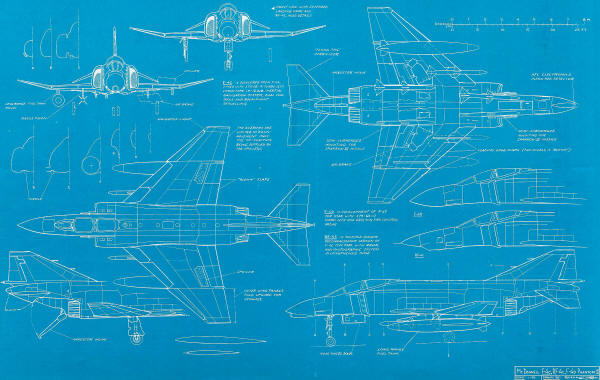
F-4 Phantom 4-View
Notice:
The AMA Plans Service offers a
full-size version of many of the plans show here at a very reasonable cost. They
will scale the plans any size for you. It is always best to buy printed plans because
my scanner versions often have distortions that can cause parts to fit poorly. Purchasing
plans also help to support the operation of the
Academy of Model Aeronautics - the #1
advocate for model aviation throughout the world. If the AMA no longer has this
plan on file, I will be glad to send you my higher resolution version.
Try my Scale Calculator for
Model Airplane Plans.
Posted September 1, 2019
|